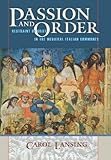Passion and Order : Restraint of Grief in the Medieval Italian Communes / Carol Lansing.
Material type: TextSeries: Conjunctions of Religion and Power in the Medieval PastPublisher: Ithaca, NY : Cornell University Press, [2018]Copyright date: ©2008Description: 1 online resource (264 p.) : 21 halftonesContent type:
TextSeries: Conjunctions of Religion and Power in the Medieval PastPublisher: Ithaca, NY : Cornell University Press, [2018]Copyright date: ©2008Description: 1 online resource (264 p.) : 21 halftonesContent type: - 9781501732249
- Burial laws -- Italy, Northern -- History -- To 1500
- Emotions -- Political aspects -- Italy, Northern -- History -- To 1500
- Grief -- Political aspects -- Italy, Northern -- History -- To 1500
- Mourning customs -- Italy, Northern -- History -- To 1500
- Medieval & Renaissance Studies
- Religious Studies
- HISTORY / Medieval
- 393/.909450902 22
- GT3390.5.I8 L36 2008eb
- online - DeGruyter
| Item type | Current library | Call number | URL | Status | Notes | Barcode | |
|---|---|---|---|---|---|---|---|
 eBook
eBook
|
Biblioteca "Angelicum" Pont. Univ. S.Tommaso d'Aquino Nuvola online | online - DeGruyter (Browse shelf(Opens below)) | Online access | Not for loan (Accesso limitato) | Accesso per gli utenti autorizzati / Access for authorized users | (dgr)9781501732249 |
Frontmatter -- CONTENTS -- List of Illustrations -- Acknowledgments -- Abbreviations -- Introduction -- 1. Grief and State Formation -- 2. Funerals and Funeral Laws -- 3. Laments and Male Honor -- 4. Ancient Laments: Sexuality, Rage, and Doubt -- 5. Intercession for the Dead and Sorrow for Sin -- 6. Lay Political Culture and Critiques of the Lament -- 7. Emotional Order and Just Order -- 8. The Seductive Dangers of Grief -- 9. Wars and Funerals in Fourteenth-Century Orvieto -- Epilogue: The Politics of Grief -- Bibliography -- Index
restricted access online access with authorization star
http://purl.org/coar/access_right/c_16ec
The way in which a society expresses grief can reveal how it views both intense emotions and public order. In thirteenth-century Italian communes, a conscious effort to change appropriate public reaction to death threw into sharp relief connections among urban politics, gender expectations, and understandings of emotionality. In Passion and Order, Carol Lansing explores a dramatic change in thinking and practice about emotional restraint. This shift was driven by politics and understood in terms of gender. Thirteenth-century court cases reveal that male elites were accustomed to mourning loudly and demonstratively at funerals. As many as a hundred men might gather in a town's streets and squares to weep and cry out, even tear at their beards and clothing. Yet these elites enacted laws against such emotional display and proceeded to pay the fines levied against themselves for violating their own legislation.Political theorists used gender norms to urge men to restrain their passions; histrionic grieving, like lust, was now considered "womanish." Lawmakers drew on a complex of gendered ideas about grief and public order to characterize governance in ways that linked the self and the state. They articulated their beliefs in terms of rules of decorum, how men and women need to behave in order to live together in society. Lansing demonstrates this change through a rich combination of sources: archival records from Orvieto, Bologna, and Perugia; political treatises; literary works, notably Petrarch's letters; and representations of grief in painting and sculpture.
Mode of access: Internet via World Wide Web.
In English.
Description based on online resource; title from PDF title page (publisher's Web site, viewed 26. Apr 2024)


